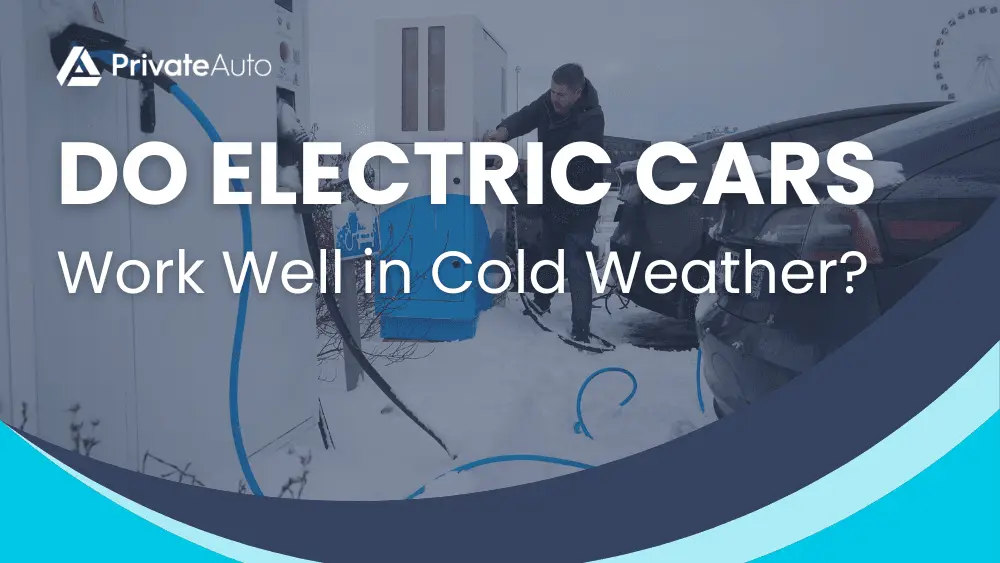
This doesn’t mean that electric vehicles are useless in cold climates, but it pays to be aware of how the cold affects them.
Also, automakers continue improving EV cold weather capabilities through better insulation, efficient heat pumps, and battery thermal controls.
What Impact Does Cold Have on EV Performance?
Electric vehicle performance is optimal at 70°F and drops with each temperature decrease below that ideal. Cold weather affects EVS in the following ways:
- Reduced battery range
- Longer charging times
- Accelerated battery degradation

Reduced battery range
Reduced Battery Range
Frigid temperatures diminish an EV’s driving range. Winter range loss happens for two reasons:
- Cold slows a battery’s chemical reactions, so the battery can’t output as much electricity. Battery performance is far lower in cold temperatures than at the 70°F ideal.
- Electric vehicle drivers crank up the cabin heat in cold climates. The heater draws power from the battery, leaving less juice to power the drivetrain.
Freezing temperatures (32°F) diminish EV driving range by an average of 30%. Some cars only lose 16% capacity at freezing, while others lose as much as 55%.
This graphic shows the range loss in freezing conditions, compared to ideal temperatures, for some of the most popular electric vehicles.

Slow charging in the cold
Longer Charging Times
Because chemical reactions happen more slowly in the cold, EV batteries take longer to charge. Automakers implement battery insulation, battery heating, and battery preconditioning measures to mitigate the effects of cold; these efforts are only partially successful.
Level 1 charging
Level 1 Charging in the Cold
At freezing temperatures, Level 1 charging doesn’t even charge the battery. Most of the juice goes to keep the battery warm. You need something stronger.
Level 2 charging
Level 2 Charging in the Cold
In freezing temps, the electricity from Level 2 charging will initially go to warm the battery. After a while—with the interval based on battery levels, battery type, and the exact temperature—the battery will begin to charge. It charges much more slowly than it would in ideal temperatures.
DC charging
DC Fast Charging
At 32°F, DC fast charging takes roughly twice as long to get a battery from 20% to 80% charge. This is an average across EV types; yours may be faster or slower.
If the battery is extremely cold, the first half hour or so of DC charge may go to warm the battery.
Battery degradation
Accelerated Battery Degradation
Cold weather wears out EV batteries faster. Several dynamics contribute to shorter battery life:
- Increased internal resistance leads to higher heat generation during charging and discharging cycles, which puts more strain on components.
- Lithium plating occurs when lithium ions, made sluggish by the cold, deposit as metallic lithium on the anode surface instead of intercalating into the graphite structure. This irreversible process reduces the battery’s capacity.
- An EV’s battery management system works harder to heat the battery pack in cold weather, which strains the system and wears it out faster.
- Regenerative braking, which extends range, is less effective in cold weather due to increased friction, resulting in higher battery discharge rates.
How to optimize for the cold
Cold-Weather Performance Tips
Here are some preventative measures to get the best performance from your EV in cold weather:
- Precondition the battery: most EVs have a feature that allows you to precondition or preheat the battery before driving or charging. This helps bring the battery to an optimal temperature range, improving both range and charging speed.
- Use battery thermal management: some EVs come equipped with battery temperature management systems that actively heat or cool the battery pack to maintain ideal operating temperatures. Make sure to use this feature in cold weather.
- Plan your route: cold temperatures reduce an EV’s range, so plan your route accordingly. Factor in stops for charging and preconditioning the battery, especially for longer trips.
- Limit energy-draining accessories: Use heaters, defrosters, and other accessories sparingly—or opt for heated seats and a heated steering wheel, which are more efficient.
- Drive like an old person: aggressive acceleration and high speeds consume more energy. Drive smoothly and at moderate speeds to maximize efficiency.
- Heat the cabin while the EV is still plugged in to conserve battery power.
- Winter tires improve traction and handling in cold, snowy, or icy conditions, so you use less juice to get where you’re going.
- Charge regularly: extreme temperatures can significantly reduce an EV’s range, so never drain your battery to empty. Top it off regularly.
- Use charging station amenities: some public charging stations offer battery preconditioning or heated parking spaces, which can help improve charging times and range.

Looking to buy or sell an EV?
PrivateAuto makes the private-party car-buying experience easy, convenient, and safe. We give you all the tools you need to buy a used EV from a private seller, from a handy scheduler to instant, fee-free payments.
If you’re trying to sell your electric vehicle, our listing process is easy and our integrated payment solution gets you paid instantly.
Electric Vehicle FAQ
What is the best temperature for electric cars?
70°F is the optimal working temperature for electric cars. At this temperature, lithium-ion batteries operate at peak efficiency without requiring heating or cooling measures. As we’ve seen, performance suffers during extreme cold.
Heat is also the enemy of driving range. This is because high temperatures accelerate the chemical aging process inside the battery cells, degrading the capacity over time. Excessive heat causes the lithium-ion batteries to expend more energy trying to keep themselves cool, reducing driving range.
How much does it cost to charge an electric vehicle at home?
Here is how much it costs to charge an EV with a 100kWh battery capacity at home.
Your actual charging costs may will depend on electricity rate fluctuations, as well as the rates charged by your utility provider (which may be different from state averages).
Do electric cars have fewer problems?
Electric vehicles tend to have fewer issues than gas-powered cars, thanks to their simplified drivetrains. With fewer moving parts, there’s less to go wrong.
EV batteries are the exception. While not prone to malfunctions, their capacity deteriorates over time. Your range decreases the longer you own the EV; eventually, you’ll need to replace the battery.
Do electric cars need oil changes?
Electric cars do not require oil changes. This is because they do not have any internal combustion engine components that need engine oil.